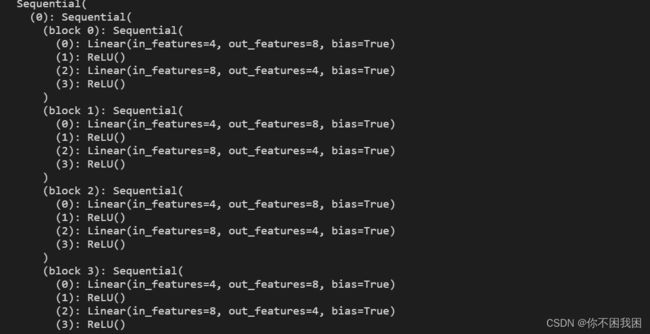从基础到卷积神经网络(第12天)
1. PyTorch 神经网络基础
1.1 模型构造
1. 块和层
首先,回顾一下多层感知机
import torch
from torch import nn
from torch.nn import functional as F
net = nn.Sequential(nn.Linear(20, 256), nn.ReLU(), nn.Linear(256, 10))
X = torch.rand(2, 20) # 生成随机输入(批量大小=2, 输入维度=20)
net(X) # 输出(批量大小=2, 输出维度=10)
2. 自定义块
自定义MLP实现上一节的功能
class MLP(nn.Module): # 定义nn.Mudule的子类
def __init__(self):
super().__init__() # 调用父类
self.hidden = nn.Linear(20, 256) # 定义隐藏层
self.out = nn.Linear(256, 10) # 定义输出层
def forward(self, X): # 定义前向函数
return self.out(F.relu(self.hidden(X))) # X-> hidden-> relu-> out
实例化MLP的层,然后再每次调用正向传播函数时调用这些层
net = MLP()
net(X)
3. 实现Sequential类
class MySequential(nn.Module):
def __init__(self, *args):
super().__init__()
for block in args:
self._modules[block] = block
def forward(self, X):
for block in self._modules.values():
X = block(X)
return X
net = MySequential(nn.Linear(20, 256), nn.ReLU(), nn.Linear(256, 10))
net(X)
4. 在正向传播中执行代码
class FixedHiddenMLP(nn.Module):
def __init__(self):
super().__init__()
self.rand_weight = torch.rand((20, 20), requires_grad=False) # 加入随机权重
self.linear = nn.Linear(20, 20)
def forward(self, X):
X = self.linear(X)
X = F.relu(torch.mm(X, self.rand_weight) + 1) # 输入和随机权重做矩阵乘法 + 1(偏移)-》激活函数
X = self.linear(X)
while X.abs().sum() > 1: # 控制X小于1
X /= 2
return X.sum() # 返回一个标量
net = FixedHiddenMLP()
net(X)
5. 混合搭配各种组合块的方法
class NestMLP(nn.Module):
def __init__(self):
super().__init__()
self.net = nn.Sequential(nn.Linear(20, 64), nn.ReLU(),
nn.Linear(64, 32), nn.ReLU())
self.linear = nn.Linear(32, 16)
def forward(self, X):
return self.linear(self.net(X)) # 输入-> net-> linear中
chimera = nn.Sequential(NestMLP(), nn.Linear(16, 20), FixedHiddenMLP()) # (32, 16)->(16, 20) ->(20, 1)
chimera(X)

总结:
1、在init中写各种层
2、在前向函数中调用init中各种层
有很强的灵活性
1.2 参数构造
具有单隐藏层的MLP
import torch
from torch import nn
net = nn.Sequential(nn.Linear(4, 8), nn.ReLU(), nn.Linear(8, 1))
X = torch.rand(size=(2, 4))
net(X)
print(net[2].state_dict()) # 拿到nn.Linear的相关参数
![]()
访问目标参数
print(type(net[2].bias))
print(net[2].bias)
print(net[2].bias.data)
net[2].weight.grad == None # 梯度是否为0,因为此时还没有计算,所以没有梯度
print(*[(name, param.shape) for name, param in net[0].named_parameters()])
print(*[(name, param.shape) for name, param in net.named_parameters()])
net.state_dict()['2.bias'].data # 访问最后一层的偏移
def block1():
return nn.Sequential(nn.Linear(4, 8), nn.ReLU(),
nn.Linear(8, 4), nn.ReLU())
def block2(): # block2嵌套4个block1
net = nn.Sequential()
for i in range(4):
net.add_module(f'block {i}', block1())
return net
rgnet = nn.Sequential(block2(), nn.Linear(4, 1))
rgnet(X)
print(rgnet) # 查看网络结构
def init__normal(m): # 传入的module
if type(m) == nn.Linear: # 如果传入的是全连接层
nn.init.normal_(m.weight, mean=0, std=0.01) # 内置初始化,均值为0方差为1,.normal_替换函数不返回
nn.init.zeros_(m.bias) # 所有的bias赋0
net.apply(init__normal) # 对神经网络模型net中的所有参数进行初始化,使用init_normal()函数对参数进行随机初始化
net[0].weight.data[0], net[0].bias.data[0]
def init_constant(m):
if type(m) == nn.Linear:
nn.init.constant_(m.weight, 1) # 将m.weight初始常数化为1
nn.init.zeros_(m.bias)
net.apply(init_constant)
net[0].weight.data[0], net[0].bias.data[0]
对某些块应用不同的初始化方法
def xavier(m):
if type(m) == nn.Linear:
nn.init.xavier_uniform_(m.weight) # 使用Xavier均匀分布进行初始化
def init_42(m):
if type(m) == nn.Linear:
nn.init.constant_(m.weight, 42)
net[0].apply(xavier) # 第一个层用xavier初始化
net[2].apply(init_42) # 第二个层用init_42进行初始化
print(net[0].weight.data[0])
print(net[2].weight.data)









